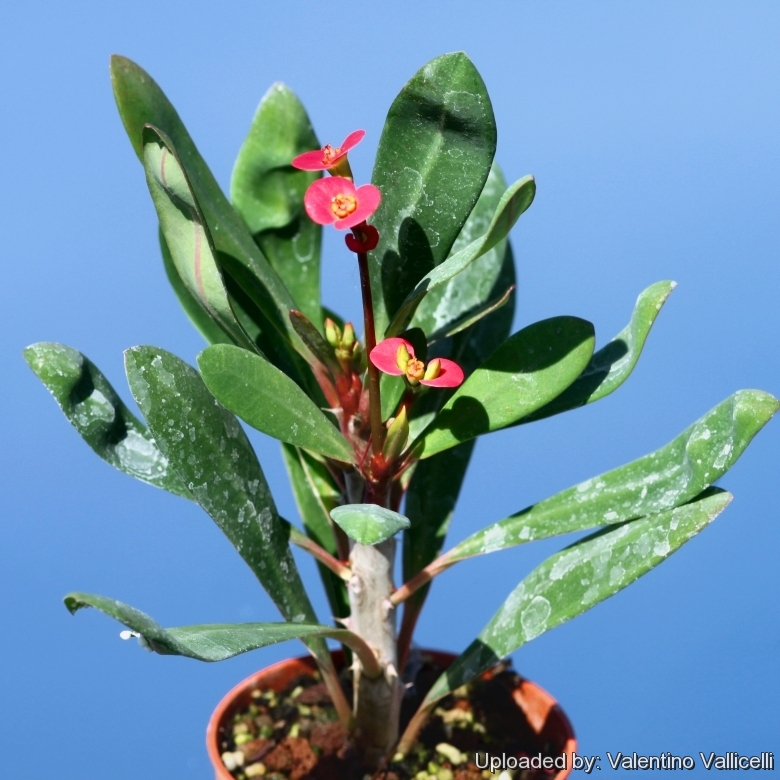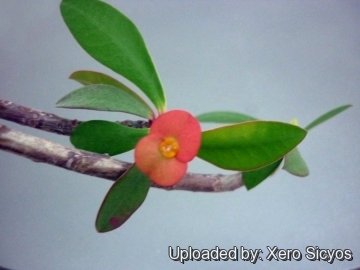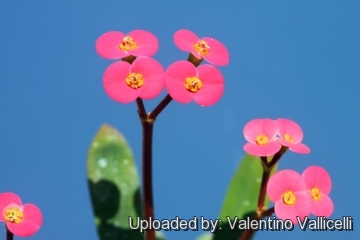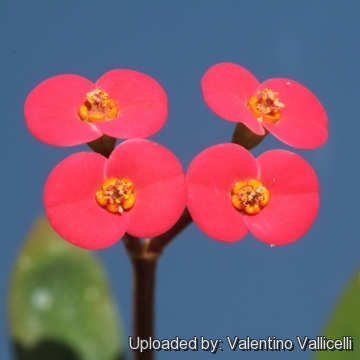




Your support is critical to our success.

Origin and Habitat: This poorly known species is endemic to the rocky areas of the Anosivola river, a tributary of the Mangoro, south of Mahanaro, between Toamasina (Tamatave) and Mananjary in the east coast of Madagascar on the Nosivolo (Mangoro).
Habitat and ecology: Euphorbia tardieuanaSN|31090]]SN|31090]] grows on barren granite rocks, but hasn’t been recollected since the type collection in 1927 and grows in a highly degraded part of the eastern evergreen forest. E. tardieuana is very uncommon in habitat and may eventually be listed as critically endangered or even extinct once further field work has taken place. Major Threats are habitat degradation, fire, habitat clearing for timber and collection for the horticultural trade.
Synonyms:
- Euphorbia tardieuana Leandri
Description: Euphorbia tardieuanaSN|31091]]SN|31090]] is a semi-succulent shrub to ca. 1 m tall which can be easily trimmed without harming the plant. The flowers are reduced in size and aggregated into a cluster of flowers called a cyathium (plural cyathia) each of them subtended by a pair of conspicuous brilliant red petaloid bracts (cyathophylls) that resemble, from a distance, geraniums. E. tardieuana is related, if not synonymous to Euphorbia mangelsdorffiiSN|31090]]SN|31091]].
Stems: Branches round, succulent, bark red-brown.
Leaves: Deciduous, obovate, 3-4 cm long and to 14 mm wide, apex obtuse, subapiculate, subsessile; stipules very small, soon deciduous.
Inflorescences: Subterminal, peduncle short, up to 2 cm long.
Flowers (cyathia): 2 to 4 in a cluster, shortly stalked. Cyathophylls spreading, ovate bright red.
Fruit: If the flower is pollinated, the stamens dry, and a shine green fruit (a triangular capsule) with three round seeds ripens in the warm days.
Bibliography: Major references and further lectures
1) Haevermans, T. 2004. Euphorbia tardieuana. The IUCN Red List of Threatened Species. Version 2014.3. <www.iucnredlist.org>. Downloaded on 20 April 2015.
2) Werner Rauh “Succulent and xerophytic plants of Madagascar” Volume 1 Strawberry Press, 1995
3) Wikipedia contributors. "Euphorbia tardieuana." Wikipedia, The Free Encyclopedia. Wikipedia, The Free Encyclopedia, 17 Mar. 2013. Web. 20 Apr. 2015.

Euphorbia tardieuana Photo by: Valentino Vallicelli

Euphorbia tardieuana Photo by: Xero Sicyos

Euphorbia tardieuana Photo by: Valentino Vallicelli

Euphorbia tardieuana Photo by: Valentino Vallicelli
Cultivation and Propagation: Euphorbia tardieuana is cultivated as an ornamental, and is a particular favourite houseplants. Cultivation of this plant is the same as that for the other shrubby varieties of Euphorbia from tropical areas (Madagascar, and central Africa), but it is one the easiest of all.
Growth rate: It is a relatively fast growing species.
Exposure: Full sun to lit shade appears to be the optimum range, but can tolerate the most shade, and a plant that has been growing in shade should be slowly hardened off before placing it in full sun as the plant will be severely scorched if moved too suddenly from shade into sun.
Wind and salt tolerance: This species is particularly tolerant of seaside conditions and salt spray, making it an excellent choice for planting along the coasts.
Waterings: Relatively flexible in its watering requirements. They can be watered regularly as long as the medium is open and well drained. As with any normal plant when watering, it is best to do so thoroughly, until a little water comes out through the drain holes. Allow the medium to dry out somewhat between waterings. Reduce watering to once every 1 month during winter. Space plants apart to allow air movement between branches and leaves. This will help with evaporation of extra water droplets collected during watering.
Soil: The ideal potting-medium is one with good moisture-retaining capacity but open and well drained with some extra manure for added nutrition.
Fertilization: Regular fertilizing with low nitrogen and high phosphorus and potassium ratios are preferred. Feed during spring and summer to mid autumn and withhold feeding during winter.
Maintenance: Tall plant will benefit from being staked, with bamboo or other suitable stakes. In the absence of staking, the stems of the plants may snap under the weight.
Hardiness: Very tender, protect from frost. As the natural way they need in winter at least 12 to 15 °, with adequate irrigation but have no problems with it, to stand next to radiators.
Pest and diseases: Mildew can occur in high humidity.
Propagation: Cuttings It is recommend taking Euphorbia cuttings in Spring/Summer when the plant is growing so that they have a better chance of success. They key is heat & good air circulation. These cuttings should be dipped in Hormone powder (but it is not needed) and left for a period of 3-4 weeks to callous. Then pot the cutting and don't water ( or kept slightly moist) until rooted. These will root just fine, if you can put the pot outside in the summer, or put pot on a heating pad.
Warning: The milky sap produced by this shrub has been known to cause burning and blistering of the skin, and even temporary blindness, and death may result if any of its parts are eaten. All of these problems can be avoided if care is taken when handling the plant.
| Your Actions | |
|---|---|
| Back to Euphorbia index | |
| Back to Euphorbiaceae index | |
 |
Back to Succulents Encyclopedia index |
Privacy stantement - Terms and conditions - How to cite - About us - Feedback - Donate




